|
|
|
Sort Order |
|
|
|
Items / Page
|
|
|
|
|
|
|
| Srl | Item |
| 1 |
ID:
144453


|
|
|
|
|
| Summary/Abstract |
How do religious civil wars evolve? Many violent conflicts are fought between groups of different faiths. The paper argues, however, that religious differences rarely directly lead to conflict onset. Rather, the apparent religious dimension of many civil wars is a consequence of successful religious framing. Political and military leaders offer religious interpretations designed to legitimize the use of force and to mobilize believers to violent action. Such framing processes can be more or less successful, depending inter alia on the authority of the political and religious leadership, on the coherence and appropriateness of the frames, on the existence of persuasive counter-frames, and on the availability of communication infrastructures that allow for effective dissemination of religious frames. Comparing violent conflicts in the Philippines and Thailand, the paper shows that religious mobilization can fail along the theoretically predicted lines.
|
|
|
|
|
|
|
|
|
|
|
|
|
|
|
|
| 2 |
ID:
144448
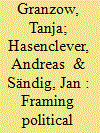

|
|
|
|
|
| Summary/Abstract |
The papers of the special issue analyse intra-state conflict escalation and armed rebellion from a framing perspective. Following Robert Benford and David Snow, framing is understood as strategic communication to mobilise a constituency for political action through persuasive ‘collective action frames’.1 Such collective action frames comprise the identification of common grievances and responsible actors (diagnostic frame), possible solutions to the identified problems (prognostic frame) and sufficiently strong reasons to push a constituency into political action (motivational frame). In our understanding, ‘collective action frames’ can mobilise people for various forms of contentious behaviour (including armed rebellion), but they can also fail to resonate with the audience. Thus, we expect political violence to occur only if framers make a convincing and resonant ‘call to arms’. In order to show that collective action frames indeed matter for various forms of political violence and most importantly civil war, the special issue investigates two aspects in detail: First, the contributions trace the selection and development of collective action frames (in particular those that propagate violence) and analyse the framing strategies deployed by movement leaders. Second, the authors of this special issue seek to explain why some ‘calls to arms’ resonate and make a constituency support an armed group, whereas others fail to ‘sweep the audience’.
|
|
|
|
|
|
|
|
|
|
|
|
|
|
|
|
| 3 |
ID:
144450


|
|
|
|
|
| Summary/Abstract |
Why do some protest movements erupt into rebellion, whereas others protest peacefully under similar circumstances? Addressing this question, this paper investigates the cases of Boko Haram (rebellion) and MASSOB (non-violent protest) in contemporary Nigeria. Conventional explanations of rebellion focusing on opportunity, inequality, and repression cannot explain why these movements have pursued different protest strategies. This paper tries to explain this puzzle by investigating the signifying work and meaning construction of both movements drawing on the framing approach from social movement studies. The framing analysis shows that the different protest behavior largely results from the differing cultural context of both movements, from the agency of the framers, and from successful frame alignment, which results in frame resonance and, thereby, the successful mobilization for collective action.
|
|
|
|
|
|
|
|
|
|
|
|
|
|
|
|
| 4 |
ID:
144454


|
|
|
|
|
| Summary/Abstract |
This article analyses the 2007–08 postelection violence in Kenya arguing that there were significant socio-spatial variations to the conflict in urban areas that can be better understood through an analysis of localised framing processes. It argues that, in some urban neighbourhoods, an underlying frame of autochthony is (re)produced through lived experience, facilitating the casting of ethnic others as either good or bad guests in times of political transition. The flawed elections of 2007 justified the violent eviction of ‘bad’ guests in these settings. This frame of autochthony, however, is absent in other urban neighbourhoods, and so these spaces remained relatively calm for the duration of the crisis. The article further argues that the flexibility of the good guest/bad guest frame enabled its reconfiguration at the local level, leading to variations in the fault lines of conflict across both time and space. It concludes that frame analysis can help to elucidate these micro-geographies of conflict.
|
|
|
|
|
|
|
|
|
|
|
|
|
|
|
|
| 5 |
ID:
144455
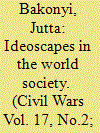

|
|
|
|
|
| Summary/Abstract |
The article uses the example of the Somali war to analyse how globally travelling ideas and political concepts are adapted to local settings and translated into frames that promote collective action and feature violence. It outlines how two ideas with universal claim, nationalism and modernisation were combined with an anti-colonial rhetoric and evolved into the meta-narrative of Somali history. This meta-narrative changed little, and keywords such as (pan-Somali) nationalism, anti-colonialism, development, sovereignty structure most of the discursive repertoires of political actors in Somalia. The main difference is that politicized clan affiliations were during the war dragged out of their shadowy existence and placed in the spot-light of political practice. They alone were however not sufficient to justify claims to power, but were complemented by ‘injustice’, ‘modernisation’ and ‘territorial’ narratives that justified violent deeds as ‘liberation’, ‘defence’ or ‘territorial rights’. Islamists employed similar key narratives and revived the pan-Somali anti-colonialist nationalism, but rooted it in a religious rational. Their ability to abandon culturalised frames contributed to their success.
|
|
|
|
|
|
|
|
|
|
|
|
|
|
|
|
| 6 |
ID:
144452


|
|
|
|
|
| Summary/Abstract |
Empirical evidence and theoretical work suggest that conflicts over self-determination are particularly likely to escalate into very violent and protracted civil wars. However, the intensity of the secessionist conflict in Casamance, Senegal, remained low. As prevailing theories on armed conflicts fail to explain the limited escalation in Casamance, this article resorts to framing theory. Framing helps to include a micro-approach towards conflict studies in order to overcome deficits of macro-approaches. It reveals how movements interpret and construct their environment in order to mobilise potential followers to participate in their activities with the help of strategic communication. However, framing only leads to collective action, if it effectively resonates with the population addressed. The article shows that the movement's framing successfully initiated rebellion in Casamance, but did not broadly resonate with the population, which accounts for the limited intensity of violence.
|
|
|
|
|
|
|
|
|
|
|
|
|
|
|
|
| 7 |
ID:
144449
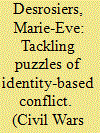

|
|
|
|
|
| Summary/Abstract |
This article assesses explanations of identity-based violence, evaluating in particular framing theory's strengths. It argues that framing specifies some of the key mechanisms and processes between factors too often studied in vacuum: the purposefulness of human beings, social structures, as well as environmental factors and opportunities. Framing therefore suggests answers to the main puzzles in conflict studies and enjoys a broader explanatory reach than existing perspectives because it coherently integrates existing theoretical insights, as well as takes us beyond them.
|
|
|
|
|
|
|
|
|
|
|
|
|
|
|
|
| 8 |
ID:
144456
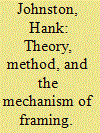

|
|
|
|
|
| Summary/Abstract |
This article bridges two literatures: research on social movements, in which framing is widely recognized as an important causal mechanism; and research in civil wars and insurgencies, which tends to deemphasize cultural-interpretative factors such as framing. We argue that it is important that insights of framing be applied to insurgencies because there is a fundamental framing action that often occurs. We have in mind civil wars in which oppositional activists, who previously had pursued nonviolent tactics, apply a prognostic frame of ‘what to do’ that specifies armed conflict. Drawing on methodologies of subject–verb–object grammars used to analyze political texts, this article elaborates a comprehensive approach to framing that involves not only shifts in the < verb>, or specifications of ‘what to do’, but also shifts in a < subject>, or definitions of ‘who we are’, and in an < object>, or the targets of ‘who the enemy is’. We use organizational texts from the first Palestinian Intifada to demonstrate the approach. We also consider frame shifts in the Syrian civil war, inferring the grammatical structures of the frame transformations for secularists and radical Islamists from events leading up to the outbreak of sustained violence. This article proposes that a three-part grammatical approach captures the interrelated elements of a full and robust framing mechanism that is generalizable. It represents an advance over framing perspectives that typically isolate identity and target components from action prognoses, therefore missing the synchronization among the three, and how limits and/or opportunities for one shape the definition of the others.
|
|
|
|
|
|
|
|
|
|
|
|
|
|
|
|
| 9 |
ID:
144451
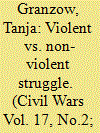

|
|
|
|
|
| Summary/Abstract |
Why do some opposition movements escalate into armed conflict while others abide non-violently under very similar conditions? In order to account for this variance, the article proposes to transcend the limitations of existing structural theories within civil war studies by including a framing perspective. It accentuates and elucidates the agency component and the interactive dynamics of the construction and negotiation of meaning, which remain a ‘black box’ in current models. In a comparative study of two movements in Yemen, the article identifies and describes the respective collective action frames, establishes why and how strategic movement actors construct them in their specific particularity, and relates this to the question of why constituents take certain forms of action. The findings assert the theoretical contribution of an integrative approach.
|
|
|
|
|
|
|
|
|
|
|
|
|
|
|
|
|
|
|
|
|